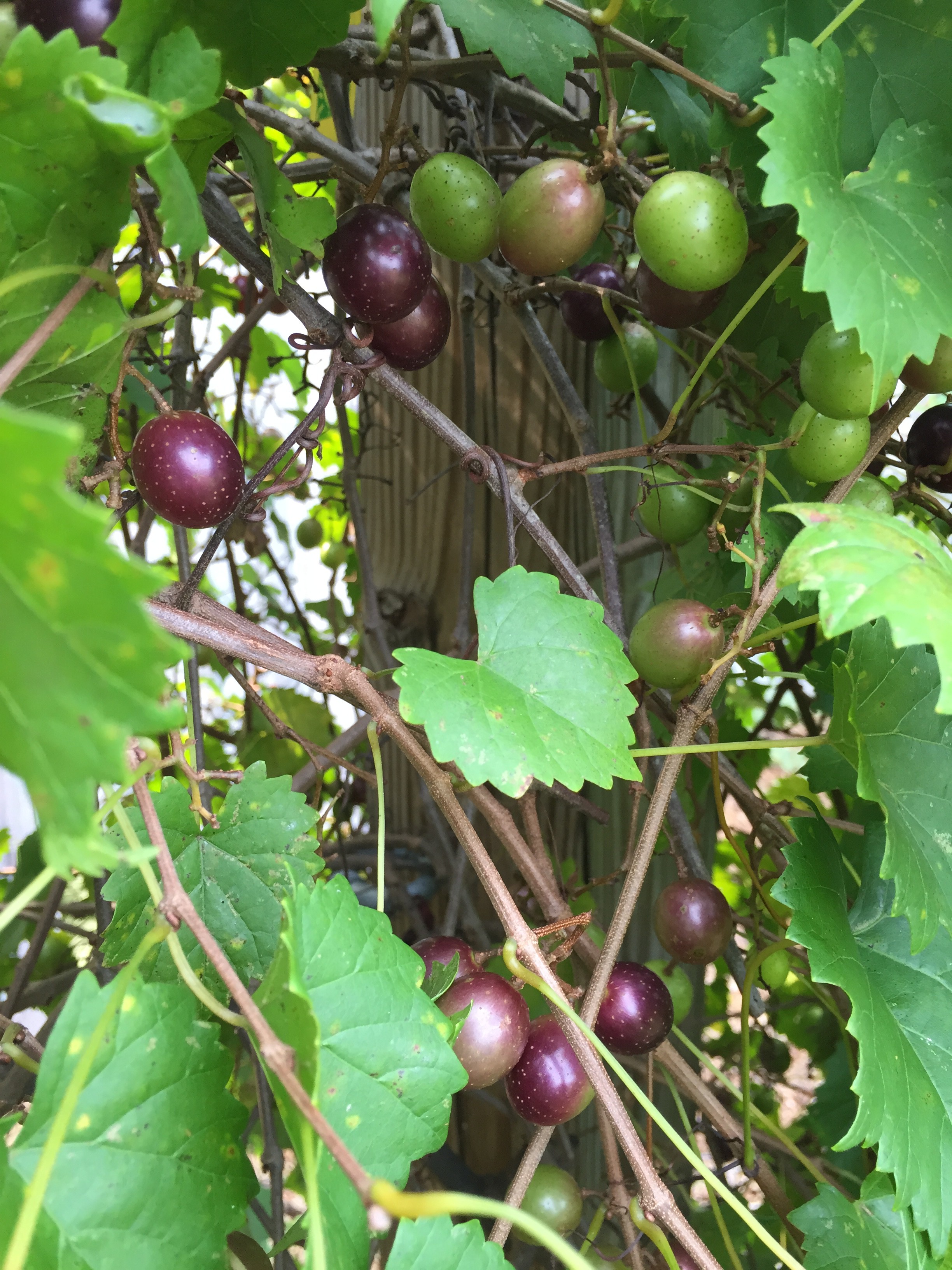
by Roy Carter | Aug 10, 2015
The muscadine grape is a popular fruit that grows very well here in North Florida. It has smaller leaves than bunch grapes and fruit are harvested singly, rather than in bunches. Theses grapes can be enjoyed fresh and also be used for home wine-making. One of the nice things about growing muscadine grapes in Florida is that they’re rarely bothered by insects or diseases. They can easily be grown in your backyard garden.
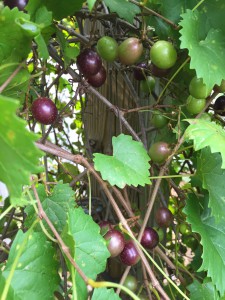
Muscadine grapes are ripening now! Photo credit: Mary Derrick, UF/IFAS Extension.
Grapes will grow well in a variety of soils here in North Florida. Upland soils with clay underlying at about three feet are ideal. You should avoid poorly drained soils. If the grapes are grown on soil with very good drainage, they should be set in the ground deeper than they were grown in the nursery on land with a high water table. Grapes should be planted on raised beds at the same depth they were at in the nursery.
During the first year, grapes should be fertilized with a quarter pound of 8-8-8 or 10-10-10 fertilizer, applied in bands about a foot away from the plant, soon after growth begins. Repeat applications in April, July and September. Fertilizer rates increase each year, but they should never exceed six pounds per vine per year.
Weeds can sometimes be a problem with muscadine grapes. To get rid of weeds, you can use a good herbicide, or you can cultivate around the plants. The muscadine grape has a very shallow root system, however, so be careful when you’re weeding around the plants. Mulches can be helpful in controlling weeds, but be sure to leave a circle of at least six inches around each vine uncovered.
Grapes need a generous supply of water to survive here in North Florida. In fact, more first-year grapes die from a lack of water than from any other cause. Make sure the plant receives about an inch of water weekly. Muscadine grapes are rarely bothered by insects or diseases. However, a spray program is advised to protect plants from possible damage by black rot or bitter rot. Spraying should begin when the vines are in bloom, and continue a regular two week intervals until about a week before the harvest. For specific information on the proper spray to use, you should contact your local County Agent.
Muscadine grapes mature in August and early September. If you don’t plan to use them immediately, they should be picked from the vine when ripe and stored at 40 degrees Fahrenheit.
For more information, please see:
The Muscadine Grape
Muscadines Benefit from Timely and Artful Pruning
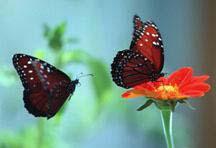
by Mary Salinas | Jul 7, 2015
Butterflies are not only beautiful to look at in your landscape; they serve as important pollinators and indicators of the health of our environment. Attracting them to your garden and incorporating some features to get them to stay and make it their home involves a little planning ahead of time for optimum results.

Queen butterfly. Photo credit: Milt Putnam, UF/IFAS.
Choose a location that provides some protection from wind. Trees and shrubs that provide wind protection also serve as a safe harbor from rain and predators. The garden should be mostly sunny with some part sun areas. Ensure that any new plantings have access to a convenient irrigation source so they can be successfully established and maintained in good health.
Now you’ll need to choose the plants. Adults feed on the nectar of many flowering trees, shrubs, perennials, and annuals and, fortunately, there are usually many choices that will meet your site requirements and your taste preferences. In order to keep the butterflies in your garden, certain plants need to be available to serve as host plants for their young. Determine which species of butterfly is common in your area and that you want to attract. Most species have very few plants on which the caterpillars can feed so those host plants need to be chosen wisely. Determine whether any of the plants you already have are host plants and they can be integrated into your butterfly garden. For example, cassia is a host plant for the Cloudless Sulphur and citrus is a host plant for the Giant Swallowtail.
In choosing your nectar plants, select those that are native or Florida-Friendly as they are lower maintenance, giving you less trouble in the long run. Choose plants that have flowers in a variety of color, size, and shape. Different butterflies like to feed at different elevations, so choose trees, shrubs, perennials, and annuals of varying heights. In order to have nectar available throughout the time when the butterflies occur, include plants that bloom at different times of the year. And include some plants that bloom from spring to late fall, like pentas or moss verbena.
Larger plants should be placed in the background with smaller plants layered in the foreground. When you plant smaller annuals and perennials, place them in masses to better attract the butterflies. Consider placing host plants in an area that is in close proximity to the nectar plants, but in an area of your garden that is not a focal point. Host plants can get quite ragged looking from hungry caterpillars!
Good maintenance practices will enhance the health of your garden. Regular fertilization and irrigation if needed will help keep your plants in bloom and healthy; healthy plants are less susceptible to disease and pests. Avoid pesticides as they may harm the very creatures you are trying to attract. Never use Bt or systemic pesticide. If you must, target a pest with lower risk oils or soaps and then only treat the affected plants. Lastly, be aware of beneficial insects that will help you achieve satisfactory control of a pest.
Now that your plants are placed there are several things to do to make your butterfly garden complete. Add a spot where water can puddle on the ground for the adult butterflies to drink. They require minerals from the soil that get dissolved in the water. Also add a rock or log in a sunny spot where butterflies can rest and sun themselves. And consider placing a comfortable place for you to sit and enjoy the beauty of your garden and its inhabitants!
For more information:
Butterfly Gardening in Florida
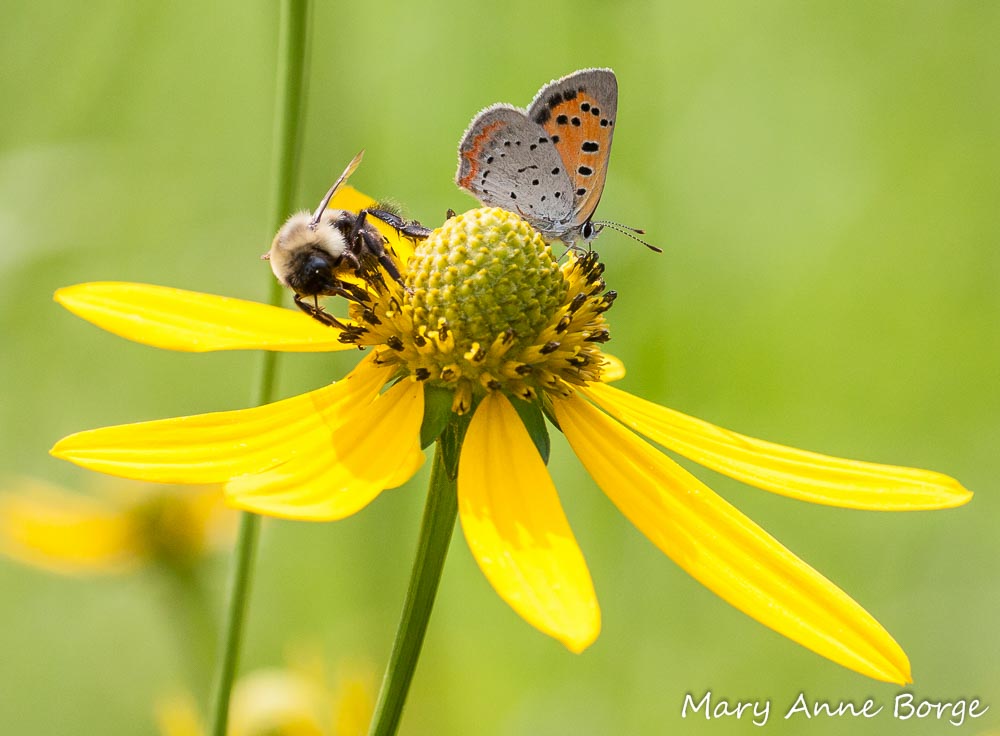
by Sheila Dunning | May 22, 2015
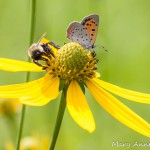 Everyone with a landscape can make a difference for pollinators. Simply Having Areas Reserved for the Environment enables homeowners, land managers, farmers, individuals, corporations, schools, roadside managers, and golf courses to increase the number of pollinators in the area by making conscious choices to include plants that provide essential habitat for bees, bats, birds, butterflies, moths, beetles, and hummingbirds. What better time than during National Pollinator Week, June 15-21, 2015.
Everyone with a landscape can make a difference for pollinators. Simply Having Areas Reserved for the Environment enables homeowners, land managers, farmers, individuals, corporations, schools, roadside managers, and golf courses to increase the number of pollinators in the area by making conscious choices to include plants that provide essential habitat for bees, bats, birds, butterflies, moths, beetles, and hummingbirds. What better time than during National Pollinator Week, June 15-21, 2015.
Initiated and managed by the North American Pollinator Protection Campaign, National Pollinator Week was unanimously approved and designated by the U.S. Senate in 2007. Each year since, the U.S. Secretary of Agriculture has signed the proclamation in an effort to address the urgent issue of declining pollinator populations.
Worldwide there is evidence that pollinating animals have suffered from loss of habitat, pesticide misuse, competition from invasive species, disease, and parasites. Many pollinators are federally “listed species”, meaning that there is documented information confirming the disappearance and/or significant population reduction in natural areas. The United States has lost over 50% of its managed honeybee colonies over the past ten years. The European Union has been so concerned that they invested over $20 million investigating the status of pollinators in Europe.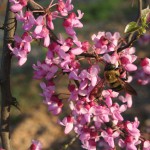
Pollinator health affects everyone. Worldwide, roughly 1,000 plants grown for food, beverages, fibers, spices, and medicines need to be pollinated by animals in order to produce the goods on which we depend. Food and beverages produced with the help of pollinators include: apples, blueberries, chocolate, coffee, melons, peaches, potatoes, pumpkins, vanilla, almonds, and tequila. In the U.S., pollination by honey bees, native bees, and other insects produces $40 billion worth of products annually.
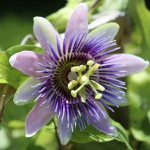 The native plants that can be identified and preserved or introduced include trees, shrubs, vines and perennials. Some of them include: Eastern Redbud (Cercis canadensis), Highbush Blueberry (Vaccinium spp.), Passionflower (Passiflora spp.), Coreopsis (Coreopsis spp.), Goldenrod (Solidago spp.), Black-eyed Susan (Rudbeckia hirta), and Butterfly Milkweed (Asclepias tuberosa). Simply identifying and avoiding damaging many of the existing native plants will allow anyone to provide important homes and food for many different pollinating animals. During National Pollinator Week S.H.A.R.E. your space.
The native plants that can be identified and preserved or introduced include trees, shrubs, vines and perennials. Some of them include: Eastern Redbud (Cercis canadensis), Highbush Blueberry (Vaccinium spp.), Passionflower (Passiflora spp.), Coreopsis (Coreopsis spp.), Goldenrod (Solidago spp.), Black-eyed Susan (Rudbeckia hirta), and Butterfly Milkweed (Asclepias tuberosa). Simply identifying and avoiding damaging many of the existing native plants will allow anyone to provide important homes and food for many different pollinating animals. During National Pollinator Week S.H.A.R.E. your space.
For additional information:
UF Native Buzz
Gardening for Pollinators
Minimizing Honey Bee Exposure to Pesticides
The Xerces Society
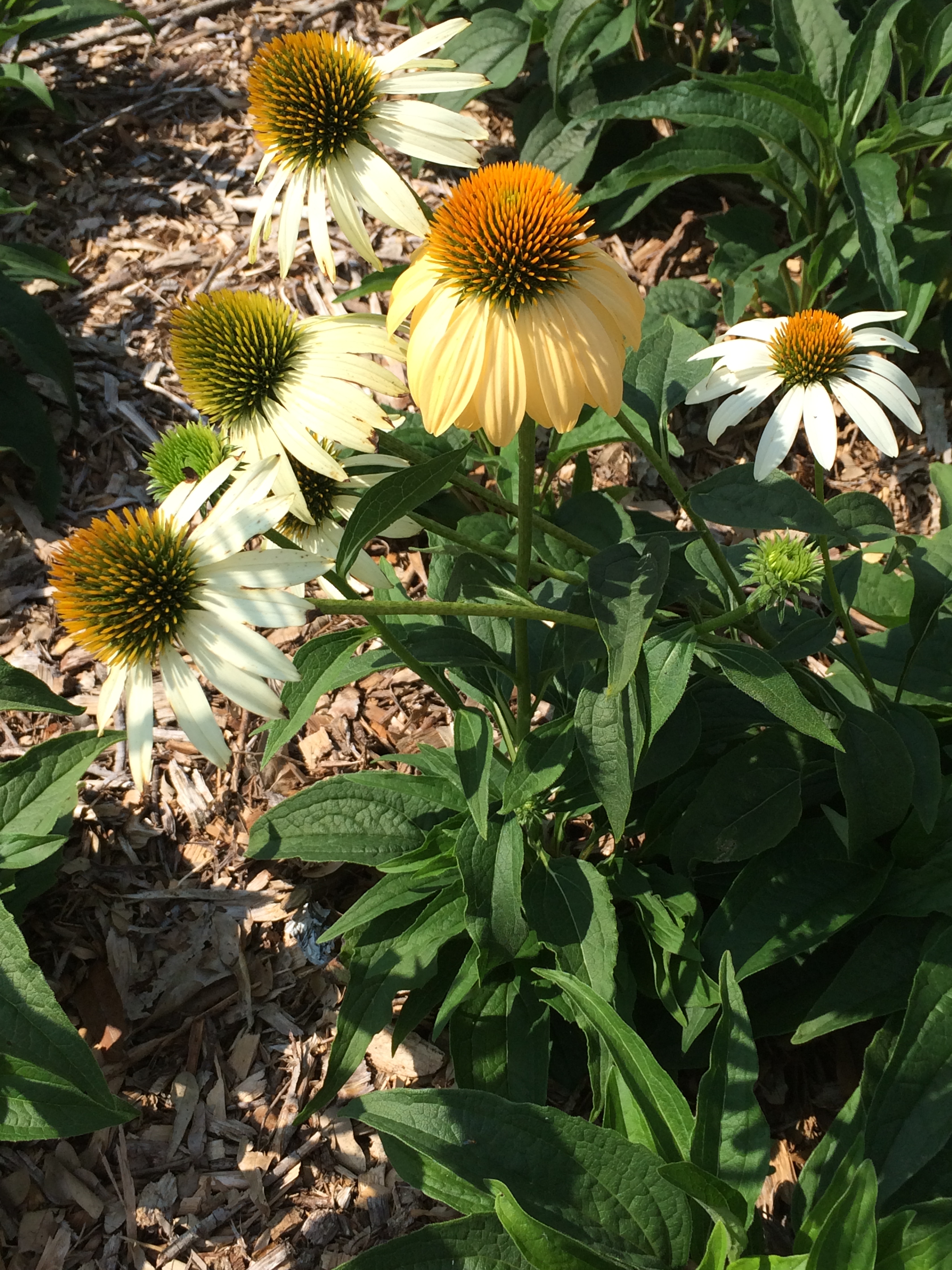
by Mary Salinas | May 12, 2015
An easy to care for perennial to add to your flower garden is the coneflower, Echinacea purpurea. The daisy-like flowers stand tall above the foliage on sturdy 2 to 4 foot stems. Blooms appear about the last part of April or the first of May in the Florida panhandle and last throughout the warm season until late fall. This Florida native reliably comes back year after year. Plant coneflower in part to full sun in rich but well-drained soil for best results.
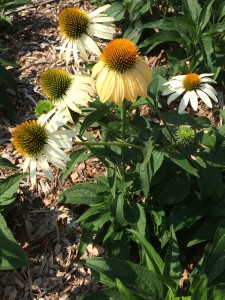
White coneflower. Photo credit: Mary Derrick, UF/IFAS Extension.
Coneflowers are traditionally purple but many new colors and variations of their form have become available from the horticultural industry. You can find them in white, yellows, pinks, oranges, and greens as well as all shades of lavender and purple. No matter what color you choose, the blooms will attract a host of butterflies and other pollinating insects. In order to protect these delicate creatures, avoid the use of pesticides when they are present.
Once you have a few coneflowers, you will notice that the clumps will grow in time and new plants will sprout from seeds left behind by the spent blooms. In our demonstration garden, this has created a stunning display that has been allowed to take over one of the garden beds. When any one clump gets too big, the number of blooms can decrease and it may be time to dig up the clump and divide it. This is a great opportunity to expand your coneflower bed or share them with some friends or neighbors!
For more information:
Ornamentals for your landscape
Butterfly Gardening
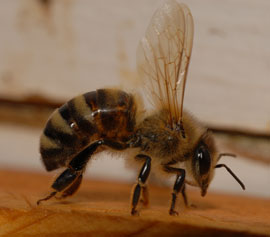
by Sheila Dunning | Apr 28, 2015
Bees have been disappearing at an alarming rate and continue to vanish without a trace. Why should anyone care? Well, they matter a lot more than most people think. Bees are the overwhelmingly dominant pollinator for most food crops. Native bees in the United States are responsible for pollinating over $15 billion worth of agricultural commodities annually. However, native bee populations are in decline due to habitat loss. At the same time, managed colonies of European honey bees have suffered a 50% decline over the past few decades. Numerous other pollinating insects are facing the same fate.

European honey bee. Photo credit: UF/IFAS.
As the spring planting season is upon us, it’s exciting to think about all the wonderful produce we will have this summer. But, without pollinators many of these crops would not be available. The majority of fruit and vegetable food sources we eat are dependent on insect pollinators. One of every three bites of food Americans consume comes from a plant visited by bees or other pollinators.
As declining numbers of farmers work to meets the need of increasing populations, they are forced to make choices on alternative to chemicals for pest control. “Good bug blends” of flowers can help attract pollinators as well as beneficial insects that suppress harmful pests. Establishment of these meadows can be done on a small or large scale and in any habitat. One approach to “bring back the pollinators” is to intercrop with blooming plants that attract insects. Selecting a diversity of plants with different flower sizes, shapes and colors, as well as various plant heights and growth habits, will encourage the greatest numbers of pollinators. It is important to provide a continuous source of pollen and nectar throughout the growing season. At minimum, strive for three species to be blooming at any one time; the greater the diversity the better.
To enhance the garden, choose flowering plants that also provide shelter for beneficial insects. Many companion plants are suitable habitat for predators and parasitoids. Research in Florida has demonstrated that predatory minute pirate bugs can build to high numbers in sunflowers. The favorite food of minute pirate bugs is Western flower thrips. So, planting sunflowers on the perimeter of vegetable crops, such as peppers, can greatly reduce the damage caused by the thrips. Similar results were found with the planting of sorghum to attract beneficial mites and intercropping with buckwheat to house syrphid flies and parasitoid wasps. The garden vegetables experienced fewer spider mite, whitefly and aphid problems. Crimson clover, Hairy vetch and cosmos are other annual seed crops that can aid in attracting pollinators and harboring beneficial insects.
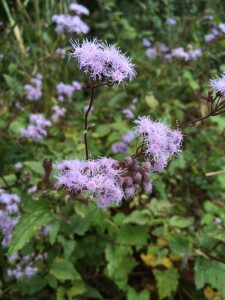
Blue Mistflower. Photo Credit Mary Derrick, UF / IFAS Extension.
Insectary meadows can be created in the landscape and along roadways, not just in the garden. For more permanently planted areas, native wildflowers, grasses and woody plants serve as larval host plants for butterflies, and also provide nesting and overwintering sites for bumble bees, predacious beetles and other beneficial insects. Native perennial wildflowers such as blanketflower, tickseed, black-eyed Susan, partridge pea, narrowleaf sunflower, milkweed, beebalm, goldenrod and silkgrass can be installed in the spring as potted plants or seeded in the fall. Seeds require exposure to cold temperatures and damp conditions before germination can occur. In Florida, the best time is November to February.
Though grasses do not offer nectar or high-quality pollen, it is often useful to include at least one native bunch grass or sedge. Short, clump-forming grasses are preferable to large, spreading grasses. Hedgerow planting of woody species is a way to provide winter-blooming plants vital for supporting pollinators. Woody plants and grasses provide more than forage for pollinators, as many native bee species nest in the stems of plants or in the undisturbed ground underneath plantings. Suitable grasses include: beaked panicgrass, purple lovegrass, Muhly grass, broomsedge,little bluestem, wiregrass and toothache grass. Favored woody species that make good “beetle banks” include: fetterbush, American beautyberry, saw palmetto, Chickasaw plum, red maple, sparkleberry, Dahoon holly, redbud, blackgum, magnolia, buttonwood and sourwood.
Regardless of whether the objective is to establish herbaceous or woody vegetation, the time and effort spent on eradicating undesirable plants prior to planting will result in higher success rates in establishing the targeted plant community. Choose level, open sites that receive full sunlight and have limited weed populations. If perennial weeds are a problem, the use of herbicides that have no soil residual (e.g. glyphosate) may be necessary.
For more information on establishing planting for pollinators visit: www.xerces.org/pollinator.











